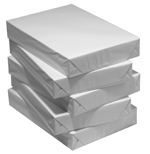Blog
The Stuff
How much weight does your MFP carry?
Posted On August 15, 2011 By Scott Guercio

One of the most common questions we get from our clients, here at Advance, is “Can we use this type of paper in our Multi-Functional Printer (MFP)?” The quickest answer comes from checking the specifications for the model of MFP in use. However, that really only gets us part of the information needed. To properly understand the capabilities of a specific MFP, it is important to understand some basic information about paper in general.
Click here to see our current hardware options for your business… we’ve moved way beyond copiers!
Most businesses are familiar with standard copier/printer paper referred to as 8.5 x11, or letter size, 20 lb. bond paper. But what does that description really mean? 20 pounds is the weight of 500 sheets of 17 x 22 size bond paper, before it is cut down into four stacks of 8.5 x 11. This is known as the basis weight. Bond is a description for the type of paper. In this case, bond refers to “plain,” uncoated paper. What is interesting is that different types of paper including bond, text, cover and index stocks have different size sheets used to determine their basis weight. This inconsistency presents a challenge in understanding how various paper weights and types relate to each other, to determine if they are within the specifications of a particular MFP. For this reason, a paper conversion chart can be used to determine equivalent paper weights.
For example, if a client would like to use 80 lb. cover stock, reading an MFP manual that states a paper tray can accommodate up to 110 lb. index stock does not exactly provide the answer needed. But it must be ok, because 80 lb. is less than 110 lb, right? Well, the answer is no. Because of the different basis weight sizes for these two stocks of paper, we must use a paper conversion chart to determine the index stock equivalent weight for 80 lb. cover, which is actually 120 lb. index. So, in this example, 80 lb. cover stock would be outside of the specifications for a tray that can handle a maximum of 110 lb. index stock.
A more direct way to understand how different types of paper relate to each other is to use the metric system rating of grams per square meter (GSM or G/M²). GSM ratings for different stocks are all based on a square meter, making any type of conversion due to different basis weight sizes unnecessary.
Another consideration needed when selecting paper for the office MFP is whether or not the paper is coated. Coated stocks, such as glossy paper, typically have their own set of guidelines for proper use. In general, most MFPs are designed to run glossy stock through the side multipurpose tray, and some only allow running a single sheet at a time. Before using this type of paper, it would be a good idea to consult the manual for the device in question.
Lastly, after the desired paper has been determined to be acceptable for an MFP, it is important to understand that the proper storage and loading of that paper can help improve performance and machine reliability. The number one enemy of paper, for an MFP, is humidity. Keeping reams of paper unopened until use is the best way to avoid humidity. When loading paper, fanning all four edges can help air separate the sheets for reliable feeding.
